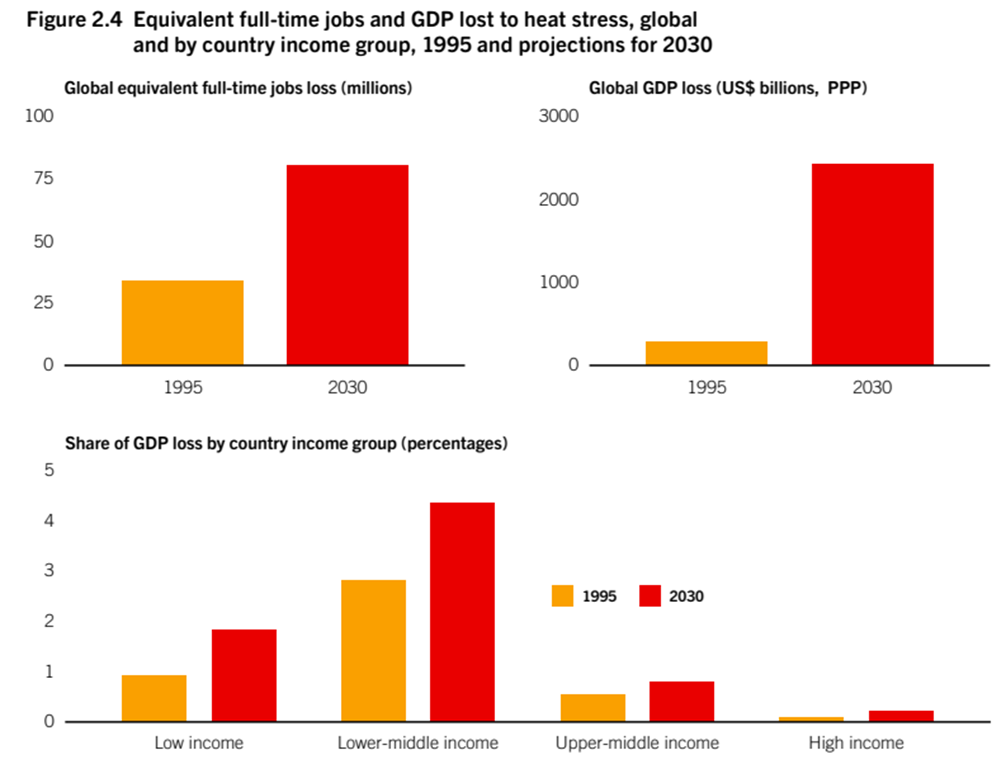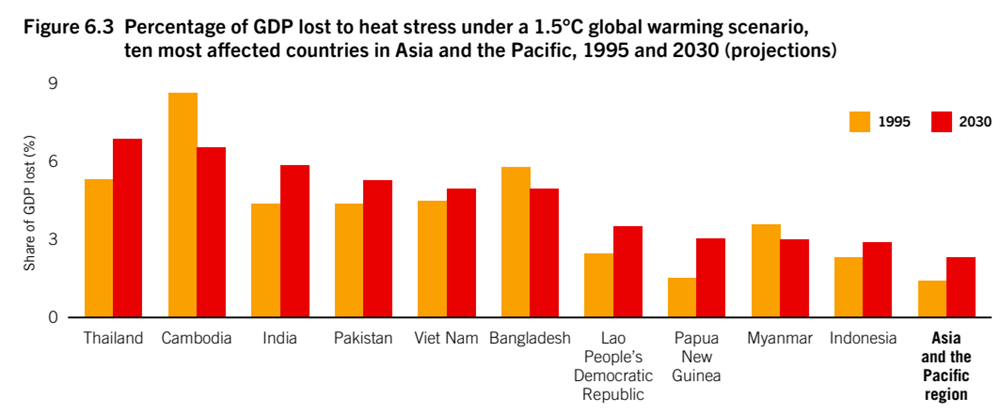HEAT STRESS IS MORE THAN A DEGREE OF CONCERN
Why in the News?
- Recent periods have seen climate change and environmental degradation significantly impact worker safety and health globally.
- Heat stress is expected to reduce labour efficiency and productivity.
- This reduction in productivity will lead to fewer work hours.
- These challenges hinder the International Labour Organization’s (ILO) goal of promoting fair and decent employment.
- Workers vulnerable to climate change hazards often continue working in hazardous conditions due to financial constraints.
Impact on Work Productivity
- Increased temperatures reduce work productivity due to excessive heat, making it difficult to work. There is a need for personnel to operate at a slower pace.
- IPCC Findings on Heat Stress
- The Intergovernmental Panel on Climate Change (IPCC) states that maintaining a core body temperature of roughly 37°C is necessary for normal physiological activities.
- Temperature elevations over 38°C negatively impact cognitive and physical capabilities.
- Health Effects of Heat Stress on Workers
- Heat stroke
- Heat cramps
- Cardiovascular disease
- Acute kidney injury
- Physical injury
- Risks for Women in Heat-Exposed Sectors: Women working in heat-exposed sectors like subsistence agriculture may face pregnancy-related complications, including:
- Hypertension
- Miscarriages
- Premature births
ILO Study Findings on Impact of Heat Stress
- Global Impact by 2030:
- Heat stress is projected to reduce total working hours worldwide by 2.2%.
- Global GDP is expected to decrease by US$2,400 billion.
- Sector-Specific Impact:
- Agricultural workers expected to be the worst affected, accounting for 60% of working hours lost to heat stress.
- Construction workers are projected to account for 19% of working hours lost to heat stress.
- Farmworkers are 35 times more susceptible to heat-related fatalities compared to other occupations.
- Exposure to Extreme Heat (2024 Estimates):
- 41 billion workers worldwide are exposed to extreme heat.
- Extreme heat at work is associated with approximately 85 million injuries and 18,970 fatalities annually.
- Regional GDP Losses:
- Asia and the Pacific regions experience the highest GDP losses due to heat stress affecting labour productivity.
- In 1995, the region’s GDP decreased by 1.4%; forecasted to decrease by 2.3% in 2030.
- Geographical Diversity and Impact:
- Asia and the Pacific exhibit exceptional climate diversity and varying levels of economic development.
- Projected decrease in working hours by 2030:
- Almost 5% in southern Asia and western Africa.
- Only 0.1% in the European subregions.
Vulnerability of Southern Asia and Sub-Saharan Africa:
These regions are most susceptible to declines in labour productivity due to heat stress. Also, these regions are already vulnerable to climate change and home to much of the world’s poor population.
- Impact on Specific Countries: Countries with a significant workforce in agriculture and construction sectors, particularly in tropical and subtropical latitudes, are most susceptible to productivity decreases.
- Thailand, Cambodia, and India are projected to see significant GDP declines of over 5% by 2030.
- Household Food Security: Decline in working hours and output among small-scale and subsistence farmers expected to affect household food security.
- Gender Disparities: Heat stress impacts labour hours and productivity unevenly across regions and genders.
- Exacerbates gender disparities, particularly for women engaged in subsistence agriculture.
- Sustainable Development Goals (SDGs): Excessive heat stress expected to impact the achievement of various SDGs.
Impact of Heat Stress in India
- Rising Temperatures:
- By 2030, an estimated 160 million to 200 million individuals in India may face deadly heat waves annually.
- Approximately 34 million people in India will experience job losses due to reduced productivity caused by heat stress.
- Productivity Decline:
- Study in West Bengal: A 1°C increase in temperature leads to a 2% decrease in productivity of female brickmaking workers.
- Working Hours Lost:
- India lost 4.3% of its working hours due to heat stress in 1995.
- This loss is anticipated to increase to 5.8% by 2030.
- Employment Impact:
- Significant decline in full-time employment expected by 2030 due to heat stress.
- Migrant workers in hazardous and physically demanding jobs, primarily in the informal economy, are particularly vulnerable.
- Lack of occupational safety, essential services, and infrastructure for informal workers.
- Financial Constraints:
- Informal workers may continue working despite health risks from extreme climate events due to financial constraints.
National Guidelines – “Preparation of Action Plan – Prevention and Management of Heat Wave”
- Developed by the National Disaster Management Authority (NDMA) and the Ministry of Home Affairs.
- It aims to protect the workforce from extreme heat impacts.
- It focuses on creating heatwave action plans for urban and rural areas, addressing the general population.
- Guidelines Focus:
- Providing education to workers.
- Ensuring proper hydration.
- Managing work schedules.
- Offering necessary medical facilities.
International Discussion on Worker Safety
- General Discussion Committee of the International Labour Conference (June 2023):
- Highlighted the urgent need for measures ensuring worker safety and health against climate-related risks.
- Emphasized the impact on mental and physical well-being and the need for secure working environments.
- Improving Occupational Safety and Health Standards
- International Labour Standards:
- Focus on improving the implementation of international labour standards related to occupational safety and health.
- Ensuring suitable working conditions for those affected by heat stress.
- Effective Communication:
- Facilitate adjustment of working hours.
- Guarantee adequate rest breaks.
- Provide access to drinking water.
- Offer training on the identification and management of heat stress.
- Mitigation of Adverse Effects:
- Implementing these measures can help alleviate the adverse effects of heat stress on workers.
- Collaboration among Stakeholders:
- Governments, employers, and workers must work together to protect the most vulnerable individuals.
- Development of infrastructure and enhanced early warning systems for extreme weather events.
- International Labour Standards:
Green Employment as a Solution
- Considering the current climate change scenario, decent and green employment is a promising solution for the future of work.
- Regulatory Measures: Government should implement adequate regulatory and legislative measures in occupations susceptible to heat waves.
- Aim to ensure the safety and well-being of workers.
- Infrastructure Measures: Implement construction standards to safeguard indoor workers.
- Benefits of Green Jobs
- Environmental Protection: Green jobs contribute to reducing environmental impacts, improving energy efficiency, and minimizing waste and pollution.
- Economic and Social Well-Being: Support sustainable development by providing stable and fair employment. Promote social inclusion and equitable opportunities.
- Climate Resilience: Help communities and economies adapt to and mitigate the impacts of climate change.
- Health and Safety: Improve workplace health and safety by reducing exposure to harmful environmental conditions.
- Sustainable Development: Contribute to achieving Sustainable Development Goals (SDGs) by integrating environmental, economic, and social objectives.
- Implementation Strategies
- Education and Training: Provide education and training programs to equip workers with skills needed for green jobs.
- Public and Private Sector Collaboration: Encourage collaboration between governments, businesses, and communities to create and sustain green jobs.
- Investment in Green Infrastructure: Invest in renewable energy, sustainable agriculture, and eco-friendly construction practices.
- Examples of Green Jobs
- Renewable Energy Technicians: Jobs in solar, wind, and other renewable energy sectors.
- Sustainable Agriculture Workers: Employment in organic farming, permaculture, and sustainable fisheries.
- Environmental Engineers and Scientists: Roles focused on environmental conservation, pollution control, and ecological restoration.
- Urban Planners and Green Builders: Professionals designing and constructing sustainable buildings and communities.
- Recycling and Waste Management Workers: Jobs in recycling programs, waste reduction initiatives, and sustainable waste management systems.
Alternative articles
https://universalinstitutions.com/on-indias-heat-action-plans/
Mains question
Discuss the role of green jobs in mitigating the impacts of climate change and enhancing worker safety, particularly in heatwave-prone regions like India. Evaluate the challenges and policy measures required. (30 words)





